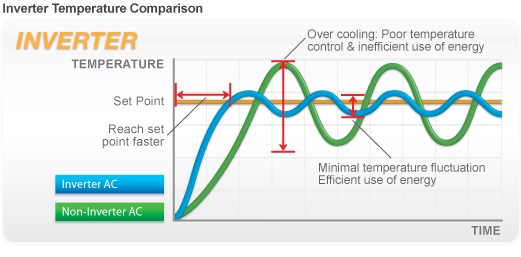There are many factors one need to consider when buying an air conditioning unit. Be it the size and type of the unit and also your budget where the cost of the same will play a role during your selection process.
During the times of rising living costs and with that cost of energy, it is important to chose the HVAC that is also energy efficient; how do you get most heating in winter and cooling in summer for the least amount energy spent is the goal here.
Inverter technology in Air conditioning
The word that comes to mind if you’ve every read or heard about efficient a/c is inverter technology. It was a major selling factor few years back and it comes standard with 90% of units made today.
The basics of the process is in the way the unit operates during it’s normal workings. In particular it is the way it oscillates and varies the intensity of its motor and compressors during temperature swings. Let’s use an example of cooling cycle.
When the room is being cooled any air conditioning unit, be it a portable window a/c, split system ductless or full blow ducted a/c, it if it an inverter type it will try to keep the temperature as constant as possible by a following process. Assuming that our ideal desired temperature is 23 degrees Celsius, while the temperature is 30 at the beginning of the operation, the unit will be working it’s hardest to drop the temperature and cool the room down to the 23 mark. Once it is close to or at the 23 mark, it will slow down it’s operation and not stop it for a while which used to be the case in a non-inverter models. It will continue to operate at a much slower rate maintaining the room temperature and also the humidity in the room.
So this technology evens out the swings in the room temperature keeping it more constant which is ideal for comfort whilst saving energy at peaks and troughs where it would have to work much harder to bring the comfort level to the desired measure. See the picture below for graphical representation of this inverter model:

 Now that you’re armed with knowledge of how air conditioners save energy, you’re ready to go into the real world and buy one. In Australia for example there are energy rating calculators that have been made easy – the more stars the better the efficiency.
Now that you’re armed with knowledge of how air conditioners save energy, you’re ready to go into the real world and buy one. In Australia for example there are energy rating calculators that have been made easy – the more stars the better the efficiency.
Here is the article outlining that exact measure: http://www.energyrating.gov.au/products-themes/refrigeration/domestic-refrigeration/star-rating/
Now it is normal to assume that a larger appliance like a ducted air conditioning system will be consuming more energy than it’s smaller split or portable systems however this rating has been developed to compare likes with likes making it a fair system that you can rely upon with great certainty. The maximum rating is 6 stars and minimum 1 star with half star increments making the scale out of 12 in real terms. So if you chose an air conditioner that has 4 stars or more and an air conditioning installation company like Frost air www.frostair.com.au make sure they are ARC certified – Australian Refrigeration Council – this is the body that regulates refrigerant handling licenses and you want to make sure your contractor installing your a/c of choice possesses a tick of approval to handle air conditioning and refrigeration equipment.
A final tip on being environmentally friendly while cooling or heating your home is to realise that the difference of 1 or 2 degrees in room temperature that you set on our air conditioning controller will translate into hundreds of dollars in saving every year so unless you must have your room cooled down bellow 20 degrees, consider setting the temperature gauge to something more reasonable and still comfortable 23 degrees Celsius. It will save you money while keeping you cool and comfortable.